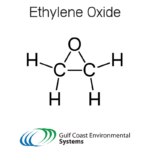Case Study – EtO Sterilizationby Gulf Coast Environmental Systems
- Location: Puerto Rico
- Employees: 925
- Industry: Medical Sterilization
- Project Type: Ethylene Oxide Abatement
- Equipment Type: Catalytic Recuperative Oxidizer
Executive Summary:
Gulf Coast Environmental Systems was tasked with providing an ethylene oxide (EtO) abatement solution to a medical sterilization company to avoid a costly shutdown.
Company Summary:
This customer specializes in contract sterilization of medical and laboratory supplies. Founded in Puerto Rico 35-years ago, they pride themselves on maintaining long-term relationships with their customers, centered on ethical behavior and values.

Project Summary:
In some regions of the world, the increased regulatory focus on ethylene oxide as a dangerous and carcinogenic volatile organic compound (VOC) has resulted in destruction thresholds being tightened from as low as 95% destruction rate efficiency (DRE) to 99.9% DRE, or less than 50 ppb. This higher rate of destruction efficiency is accomplished through changes in pollution control technologies, which some facilities have not had a chance to address. Facilities like this one are experiencing sudden and stringent crackdowns on EtO emissions, often resulting in shutdowns and fines.
Shutting down sterilization operations can result in hundreds of thousands of dollars of revenue loss per day, and a shortage of much-needed medical and surgical supplies. There are no current federal guidelines in place to regulate EtO emissions, but states across the US are actively lobbying for such action to ensure consistency in enforcement and environmental practices on a federal and state level.
This customer approached GCES with a project that required a DRE of 99.9% of pollutants in an ethylene oxide sterilization facility, running 12-hours per day. Our solution represented a quick payback, compared to potential fines or shutdowns.
Solution:
Gulf Coast Environmental Systems’ team of pollution control experts examined the customer’s process stream and determined that like many other Ethylene Oxide applications, a Catalytic Oxidizer would be the best available technology for this customer. GCES designed, manufactured, and installed a 10,000 SCFM Catalytic Recuperative Oxidizer (CRO), which was effective in meeting the VOC removal requirement. In this system, the process gas is heated to a temperature where an oxidation reaction occurs in the presence of the catalyst.
A catalyst is a substance that accelerates the rate of the chemical reaction of the volatile organic compound, without being consumed. In a catalytic oxidizer, the operating temperature is substantially less than thermal oxidation. When combined with a VOC loading level from the process stream, the system can become self-sustaining; often requiring minimal auxiliary fuel to support operation. This reaction breaks down the VOCs into carbon dioxide and water.
In addition to destroying the hazardous contaminants, including Ethylene Oxide, this unit was designed for maximum fuel efficiency. By using two heat exchangers in series, heat recovery was maximized, and auxiliary fuel minimized to reach operational temperatures. Fumes were kept under a vacuum and temperature requirements were lowered, reducing fuel needs and carbon footprint.
Conclusion:
Using Gulf Coast Environmental Systems’ Catalytic Recuperative Oxidizer, an essential medical sterilization facility was able to keep operating and have the peace of mind that their process exhaust stream has been stripped of hazardous contaminants, meeting stringent regulatory requirements, while reducing external fuel requirements, for a greener operation.
To know more, please check Gulf Coast Environmental Systems.

